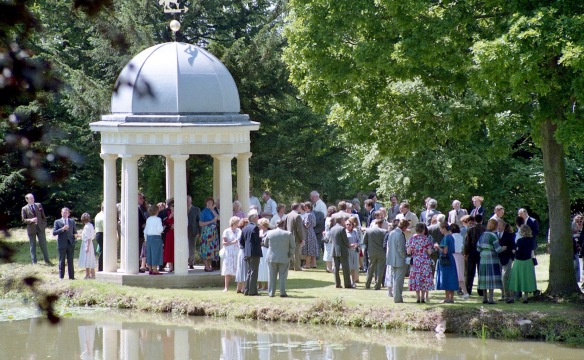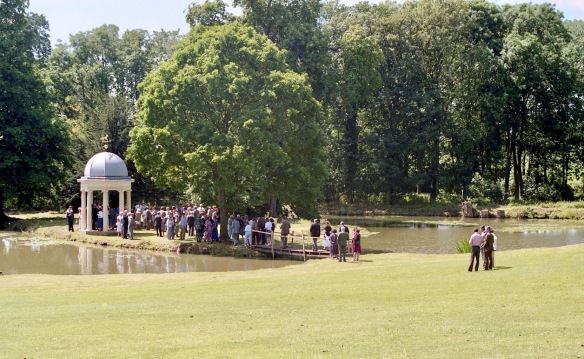CLICK ON IMAGES TO ENLARGE. REPEAT IF NECESSARY.
Another day of incessant rain led me to drafting the next section of my biography. I took some of the text from my posts ‘Holly’ and ‘Dunkirk’.
Since I am writing about the several eras of one man’s life, I have begun with what life was like in 1942. Since my blog has been about my own memories, and I don’t have any for the year of my birth, I have applied my knowledge of history and a little research. The draft itself will not appear in my posts. After all, the idea is that people don’t read it before it is finished.
Later, I scanned another batch of colour negatives, from June and July 1990.
That June, our aptly named young neighbour, James Bird, came across a family of coots that had suffered a road accident. Just one scrawny little chick survived. James knew we had a small pond, so he brought the baby bird to Jessica to care for. She did a good enough job for the creature to disappear after a few weeks. This made her rather sad. The Newark Advertiser printed an article, vainly seeking the return of the pet.
The following month we attended the grand opening of Edmund Staunton’s temple. This structure built by the gentleman farmer on his land at Staunton Manor maintains a long tradition of architectural structures, known as follies. Another I have featured on occasion is ‘Peterson’s Folly’, known as Sway Tower. Wikipedia has this to say about the genre:
‘In architecture, a folly is a building constructed primarily for decoration, but suggesting through its appearance some other purpose, or of such extravagant appearance that it transcends the range of garden ornaments usually associated with the class of buildings to which it belongs.
18th century English gardens and French landscape gardening often featured mock Roman temples, symbolising classical virtues. Other 18th century garden follies represented Chinese temples, Egyptian pyramids, ruined abbeys, or Tatar tents, to represent different continents or historical eras. Sometimes they represented rustic villages, mills, and cottages to symbolise rural virtues.[1]Many follies, particularly during times of famine, such as the Irish potato famine, were built as a form of poor relief, to provide employment for peasants and unemployed artisans.
In English, the term began as “a popular name for any costly structure considered to have shown folly in the builder”, the OED‘s definition,[2] and were often named after the individual who commissioned or designed the project. The connotations of silliness or madness in this definition is in accord with the general meaning of the French word “folie”; however, another older meaning of this word is “delight” or “favourite abode”[3] This sense included conventional, practical, buildings that were thought unduly large or expensive, such as Beckford’s Folly, an extremely expensive early Gothic Revival country house that collapsed under the weight of its tower in 1825, 12 years after completion. As a general term, “folly” is usually applied to a small building that appears to have no practical purpose, or the purpose of which appears less important than its striking and unusual design, but the term is ultimately subjective, so a precise definition is not possible.’
Helen and Bill visited for a pleasant couple of hours conversation, and departed with two trays of potted cuttings Jackie has prepared for their church sale.
We dined this evening on fish pie, cauliflower, and green beans, with which we both drank Wairau Cove Sauvignon Blanc 2016.









A very interesting post, Derrick, of both the coot and the folly.
Thanks very much, Cynthia
Fish pie sounds good.
That photo of Jessica cradling the bird reminds me of so many paintings of the Madonna and child.
The name ‘folly’ says it all.
I am made happy reading you have begun serious work on your biography! Beautiful photos of Jessica and the baby coot.
Very many thanks, Pauline
Jessica is always radiant in your photos. Thank you for sharing the story of the coot, and for explaining all about follies.
Coots and folly sounds like what’s going on in Washington right now.
Many thanks, Merril. I’m so pleased you picked up the title.
I enjoyed this–good information and the big-hearted Jessica. Who is the biography about? Glad you are writing one! But I must have missed that info earlier.
You started the book idea with one of your comments, Cynthia. Really it’s an autobiography, but also the tale of an era (your word, I think). So many others welcomed the idea that I thought I’d get on with it. Thanks very much.
Oh, that’s good news–hope it happens in entirety! I’m so glad I was a bit instrumental in nudging that original impulse. Keep us posted! (I have been lacking necessary labor with inspiration for my 2 novel manuscripts the past few years…and seem slow to submit even a poem or story to journals lately. So it goes–need to push myself more! Time is a wasting. )
I’ll try to prod you, occasionally
Beautiful shots of Jessica, Derrick. It must have been hard for her when the chick flew the coup. I’m curious about this fish pie. What kind of fish is used? I’m finicky when it comes to fish…don’t care for a fishy fish.
Jackie agrees with you on fishy fish. We use haddock, cod, and prawns. This one was a supermarket product, so I’m not sure. (The key is that if I don’t say it’s Jackie’s, then it’s bought in ) Thanks a lot, Jill
) Thanks a lot, Jill
Good luck with the (auto) biography. My book grew out of just such an endeavour where I sat down to narrate everything I remembered. It evolved in style and voice but just last week I adapted part of an early draft into my current manuscript. These memoirs are gold for the descendants. Beautiful photos and very interesting story of the folly.
I’ve been to lazy to write mine
When they give you those pills that make you feel twenty again, there’ll be no stopping you
It’s not the stopping that concerns me Gwen; it’s the starting
A journey of a thousand miles begins with . . . etc, etc, etc.
I’m into metric myself
Many thanks, Gwen. Yes it is an autobiography, but also the story of a time. Maybe I’ll call it something like ‘The Knight’s Tale’.
There was certainly a sense that I was documenting social history as I wrote. In early drafts I go off on a tangent and explain certain conditions and systems. I like the title
Many thanks, Gwen
Loved Jessica’s picture with the coot. I didn’t know that ‘folly’ has such a wide meaning in architecture. Thank you., Derrick…
Many thanks, Maniparna
Nice post, Derrick. It is good to be back checking in on everyone though I am still not totally back as our big move is on Saturday. I had the pleasure of reading several letters that were written by a couple of my Mom’s Aunties who were still living in Leeds to their Father and two sisters who had moved to Canada. I remember reading that they would go out to the folly and have picnics or to clean it up after winter. There even was talk of a wedding happening there. I was confused until I saw your pictures above. I am sure theirs was similar to the one in the photos – sort of like a gazebo! Thanks for the information!
Thanks a lot, Lydia. I’m happy to have enlightened you
I was happy just to hear you’re now serious about going through with the manuscript, Derrick – full steam ahead!!
Many thanks, GP
Good luck with the manuscript. As I well know, it’s quite an endeavor to write a book. But oh so rewarding.
Many thanks, Laurie
A cute coot.
Very interesting about the follies. Another often-overlooked function was to provide focal points within a landscaped garden, or for a large-scale landscaped garden designer to model contours and planting around. Examples of this are seen in most of the famous large gardens like Stourhead. The design leads the eye to the follies, and the follies complement the scene.
Many thanks for that supplementary information, Leslie
If the baby coot was called Ivy, we’d have the Folly and the Ivy. (Apologies in advance for have to stretch things so far in order to make an extremely weak pun).
Still worth a groan, my friend. Thanks
Nice pun!
You had me going for a minute Derrick. First you said you had a pond in the garden them the lakr photos appeared…
“Lake photos”. Sorry.
It would probably have been better if you had dug it with the help of a spade! (Sorry, couldn’t resist)
I’m sure you never look a gift horse……:)
What an enlightenment on folly, and the folly of the coot.
It is great you have already begun.
Thanks very much, Uma
The baby coot was sweet. I liked the beautiful and fashionable group of people in the series of photos of Edmund Staunton’s temple. You have an interesting life to share with a wide variety of loveky and lively characters to share with others. As you mentioned Cynthia helped to get your ball rolling in this undertaking. It is more than a life, indeed this will tell a fascinating story of the transition of time periods and new beginnings, Derrick.
Very many thanks, Robin. I’ll try to live up to your descriptions.
I love the little coot! Wishing you all the best with the memoir. You have an interesting and colorful history to share.
Very many thanks, Lavinia.